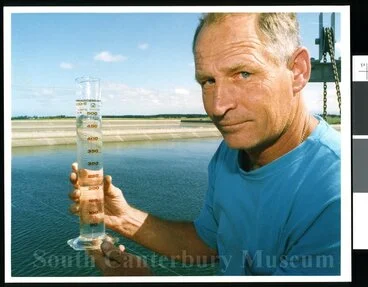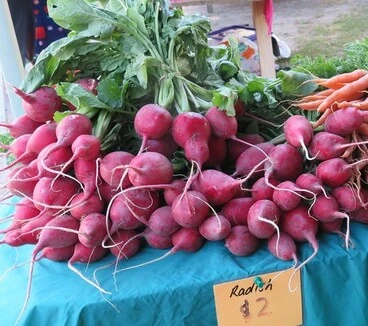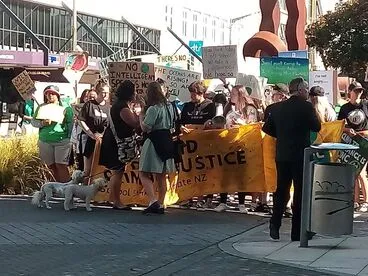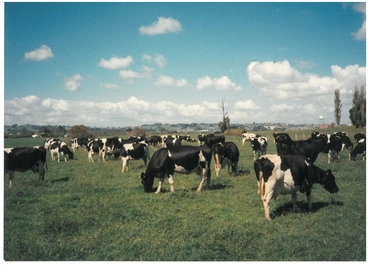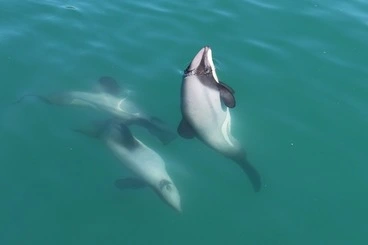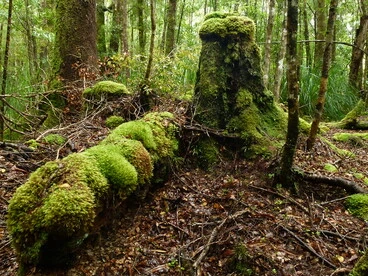Environmental Sustainability
A DigitalNZ Story by National Library Services to Schools
Environmental sustainability involves thinking about how we view the environment and its resources. This story looks at six key priorities for making use of resources in ways that ensure they will still be available for future generations.
BACKGROUND
Acting sustainably means working responsibly with the resources we have today so they will still be available for people in the future. Although sustainability goes hand in hand with conservation, it's not just about protecting the environment, but about the way we view and use resources.
Environmental sustainability is crucial for Earth's future prosperity, not only for humans but also for the plants and animals we share our planet with.
Everything we do on land and in our oceans and waterways has an impact. This can be more far-reaching than we realise, as the delicate balance of ecosystems can mean that one action or change in a way of doing something has a flow-on effect.
For example, some fertilisers and pesticides used on farms producing fruit and vegetable crops are toxic to bees and other insects that farmers rely on to pollinate their plants. This has resulted in a decline in the number of these insects worldwide and therefore greater challenges for farmers in achieving successful pollination and producing healthy and plentiful crops.
Environmental sustainability is also linked to protecting biodiversity. Biodiversity is about the variety of life forms on our planet and how they interact with each other. These relationships are what makes life on Earth possible. In short, the more species of plants and animals that become extinct, the harder it is for humans to survive and prosper.
This story explores environmental sustainability through six interrelated priorities drawn from our government's current environmental initiatives detailed on the Ministry of Environment website, and the United Nations' Sustainable Development Goals.
CONTENTS
- Sustainability and human health
- Access to clean water
- Using sustainable energy sources
- Sustainable food production
- Addressing climate change
- Harvesting marine life sustainably and protection of ecosystems
- Sustainable land use and protection of ecosystems
- Glossary
- Supporting resources
Aotearoa New Zealand has many picturesque landscapes, but our environment is not always as healthy as it looks.
Lincoln University
SUSTAINABILITY AND HUMAN HEALTH
Research shows a direct connection between human health and the health of the environment. In a balanced, healthy ecosystem the microorganisms responsible for causing disease in humans can be kept in check.
A recent paper published by the WWF (World Wildlife Fund) suggests that when humans make changes to ecosystems, plant and animal species become extinct, and biodiversity is reduced, the risk of the spread of infectious diseases increases.
This includes diseases that originate from animals and are transmitted to humans, which are called zoonotic diseases. Many of the epidemics and pandemics that humans have faced throughout history and today, have originated from animals, including COVID-19.
Scientists have suggested that using sustainable practices is a key tool in reducing and combating these risks.
Indeed, worldwide understanding of the importance of sustainability to human health is growing. The IPBES (Intergovernmental Science-Policy Platform on Biodiversity and Ecosystem Services) website includes an article that recommends sustainable practices as a focus of COVID-19 recovery programmes.
This Conservation Week poster focuses on the importance of our relationship with the environment.
Auckland War Memorial Museum Tāmaki Paenga Hira
QUICK FACTS
- Microorganisms (including viruses, bacteria and fungi) are present in every ecosystem worldwide; the majority are harmless, but others cause disease.
- When ecosystems are in balance, it is believed that the natural world can provide protections that reduce the development of new diseases, as well as the severity of the impact of known diseases.
- The closer wild and domesticated animals live to humans, and the further humans push into areas that were once forested, the greater the chance of coming into contact with animals that carry microorganisms that can result in zoonotic diseases.
- Runoff of nitrogen and phosphorous from farming can make conditions more suitable for certain harmful microorganisms to thrive.
- Loss of vertebrates (birds, fish, amphibians, reptiles, mammals) from ecosystems can create the right conditions for arthropods (insects) that carry diseases to multiply.
- A decrease in plant biodiversity can allow for some species to increase in number. For example, the loss of plant species in the Amazon has resulted in an increase of malaria carrying mosquitoes.
- Climate change is thought to be causing in an increase in zoonotic disease as animals are able to expand into areas which were previously too cold for them to survive in.
Don't kill your country
Auckland War Memorial Museum Tāmaki Paenga Hira
ACCESS TO CLEAN WATER
Compared to many countries, New Zealand’s lakes and rivers are clean and clear, and the tap water is of good quality.
Water quality can vary – for instance, it may not be drinkable, but is usable for washing.
There are laws that protect New Zealand’s water, and control how it is used. The strictest standards are for drinking water. Councils test lakes and rivers for pollution, and sometimes certain fish species are used to eat up unwanted water weed. Farmers have to follow guidelines about using fertiliser and effluent, to reduce pollution in streams and lakes.
Source: Water quality, Te Ara - the Encyclopedia of New Zealand, (accessed 30 April 2020).
A dramatic example of a waterway full of sediment caused by deforestation, flowing towards the ocean.
Manatū Taonga, the Ministry for Culture and Heritage
QUICK FACTS
- Deforestation to convert forested land for farming causes erosion and results in sediment from the land being washed into waterways. Leaving areas of bush on land, particularly steep areas, and re-planting along waterways to combat this makes farming more sustainable.
- The Clean Streams Accord came in to force in 15 regions throughout New Zealand in 2003. It was a way to reduce the adverse effects of dairy farming on water quality and move the industry towards more sustainable practices.
- Manufacturing has also polluted our waterways, and untreated effluent and sewerage are still discharged into waterways because of poor wastewater management. This can result in water supplies becoming contaminated with diseases harmful to humans.
- In urban areas, what goes down the stormwater drains matters. These drains can contain toxic elements such as zinc, lead, copper and chromium that harm river and marine life and make water unsafe to use.
BeckerFraserPhotos October 2010 photograph 015
UC QuakeStudies
Clean Streams Accord
Manatū Taonga, the Ministry for Culture and Heritage
Mike Schaab, Timaru reservoir supervisor
South Canterbury Museum
USING SUSTAINABLE ENERGY SOURCES
Energy is measured in ‘petajoules’ – one petajoule is equal to 28 million litres of petrol, or 277.7 gigawatt-hours of electricity. In 1924 New Zealanders used 86 petajoules of energy – by 2000 it had risen to 772. In 2008 primary energy came from:
- oil – 37.7%
- gas – 22.6%
- geothermal power – 12.5%
- water (hydroelectricity) – 11.3%
- coal – 9.2%.
Water and geothermal power are renewable energies – they don’t use up resources in the environment. Other renewable energies such as wood, wind and solar power, and biogases provided 6.7% of energy.
Source: Energy supply and use, Te Ara - the Encyclopedia of New Zealand, (accessed 30 April 2020).
New Zealand scientists are also working on developing the following sustainable energy sources:
- wave, tide and current energy
- biodiesel - made from vegetable oil, tallow and ethanol
- biogas - produced from food, farm and sewerage waste
- biomass - wood residue that can be used as fuel.
New Zealand has many sites suitable for generating power by harnessing the energy of the wind.
Manatū Taonga, the Ministry for Culture and Heritage
QUICK FACTS
- Fossil fuels, coal, oil and gas, are not sustainable energy sources as they are finite (will run out), and their extraction, production and use contribute to climate change.
- As the world's fossil fuel supplies decline, ways of generating energy that is sustainable (also called renewal) are vital.
- Some countries generate nuclear energy which is made from waste that is a by-product of the process.
- Energy is needed primarily to generate electricity and in New Zealand, we have several renewable energy sources including water, wind, solar and geothermal.
- Questions are being raised about the use of geothermal energy for power generation as iwi and scientists have noticed a decline in the amount of water available in pools and springs in the geothermal fields of the central North Island. This indicates that the current level of extraction is not sustainable.
Geothermal power plant, Taupō
Manatū Taonga, the Ministry for Culture and Heritage
Clyde dam
Manatū Taonga, the Ministry for Culture and Heritage
Lake Hoare solar panels
Antarctica New Zealand
SUSTAINABLE FOOD PRODUCTION
Producing food can harm the environment by:
- damaging native plants and animal habitats
- using up some of the nutrients in the soil
- causing soil erosion
- polluting rivers, streams and underground water with chemicals from fertilisers and waste from animals
- using up water from rivers
- making greenhouse gases.
The contribution of agriculture to New Zealand’s total greenhouse gas emissions is significant – over 50%, compared to the global average of 14%. In 2004 livestock contributed 90% of methane emissions and over 95% of nitrous oxide. Since 1990 New Zealand’s agricultural emissions have grown by about 1% each year.
Source: Farming and the environment - Biodiversity and greenhouse gas changes, Te Ara - the Encyclopedia of New Zealand, (accessed 30 April 2020).
Food waste makes a significant contribution to greenhouse gas emissions.
UC QuakeStudies
QUICK FACTS
- Intensive dairy farming has created problems in New Zealand through high water usage, effluent discharge and biogenic methane emissions from cows.
- Finding ways to make this type of farming more sustainable is being explored by scientists and farmers.
- Growing crops that are suitable to their environment is a way to produce food more sustainably as less water, energy and chemical fertilisers are needed to help plants grow.
- Buying locally grown food is more sustainable as transport and other costs are reduced
- Food miles is a term for calculating the cost of transporting food to customers from the place it was grown, however the accuracy of this method is now in doubt.
- The gases created when food rots are harmful to the climate. There are many initiatives to reduce food waste, including using worm farms to turn waste into compost that can then be re-used for growing more food.
- There is some debate about the sustainability of organic farming - while there are no chemicals used and soil health is a priority, more land is required to produce the same amount of food as could be produced using more traditional farming methods.
Raphanus
iNaturalist NZ — Mātaki Taiao
Ten-hectare worm farm
Manatū Taonga, the Ministry for Culture and Heritage
ADDRESSING CLIMATE CHANGE
The climate is the average weather over a long period of time. The climate depends on how much radiation (heat) reaches the earth from the sun, and how much radiation is given off by the earth. Normally this is roughly equal, and allows life on earth to exist. Anything that upsets this balance will cause temperatures to change.
To accurately predict human-induced changes in New Zealand’s climate, scientists need to know the global extent of greenhouse gas emissions, future changes in carbon dioxide concentrations, and the influence of New Zealand’s topography on local climate. Each of these factors comes with uncertainties. For example, gauging future emissions relies on anticipating human behaviour, including the success of constraints negotiated under the United Nations Framework Convention on Climate Change. Our understanding of the carbon cycle and of sources of non-carbon dioxide greenhouse gases is also incomplete.
Source: Climate change, Te Ara - the Encyclopedia of New Zealand, (accessed 30 April 2020)
Climate change results in a range of negative impacts that sustainable practices can help counteract.
Palmerston North City Library
QUICK FACTS
- Some of the effects of climate change include droughts, storms, heatwaves, wildfires, flooding, melting glaciers and ice sheets, rising sea levels and coastal erosion.
- Although Earth's climate has varied throughout time, these changes were the result of natural phenomena such as volcanoes and changes in the Earth's orbit of the sun.
- Extensive scientific research over many years has led climate scientists to a consensus (agreement) that the current changes to our climate are the result of human activity.
- Reducing greenhouse gases is a significant way to make a difference to climate change - we can use sustainable practices in farming and agriculture, including halting further deforestation.
- Reducing, and eventually eliminating, the use of fossil fuels for generating energy and transportation will have a significant impact on climate change.
Christchurch pollution
Manatū Taonga, the Ministry for Culture and Heritage
The dairy herd at Warwick Hoyte's town milk supply
Howick Historical Village
Burning forest, Taupo
Museum of New Zealand Te Papa Tongarewa
HARVESTING MARINE LIFE SUSTAINABLY AND PROTECTING ECOSYSTEMS
By international standards New Zealand’s coastal waters are relatively clean, although in areas close to larger centres they are more polluted. Little is known about the state of waters beyond the coastal zone. In 1976, local authorities were asked to subjectively rate estuaries in their areas. Of 162 estuaries rated, 38% were regarded as clean, 41% as slightly polluted, 16% as moderately polluted, and 4% as grossly polluted.
In New Zealand there are strict limits (quotas) on how many fish and shellfish can be taken. And by law the fishing industry has to consider how fishing affects the environment. But seals, dolphins, turtles, albatrosses and other protected creatures are caught accidentally by fishing nets and hooks. Deep-sea trawlers drag nets along the ocean floor, damaging corals, sponges and other marine life.
Source: Marine conservation - Pollution, Te Ara - the Encyclopedia of New Zealand, (accessed 30 April 2020)
Marine reserves are an important way to protect marine ecosystems and biodiversity in our oceans.
Manatū Taonga, the Ministry for Culture and Heritage
QUICK FACTS
- New Zealand's fish stocks are controlled and made more sustainable by the Government through a quota system that sets catch limits for key fish species
- However, regulation to control fishing in international waters, such as the wider Pacific, is very difficult.
- Dredging and trawling are fishing methods that are unsustainable because of the widespread damage they cause to the seafloor and the unnecessary killing of bycatch, including dolphins, seals and seabird species.
- Consumers can chose to buy fish that are sustainable species by using the Best Fish Guide published by Forest and Bird.
- Working to eradicate introduced species such as foreign marine organisms that arrive on ships, is a way to protect ecosystems and biodiversity in our immediate waters.
- Actively finding ways to reduce climate change is another way to protect ocean ecosystems as this will reduce acidification caused by excess CO2 in the atmosphere. Scientists believe this has a negative impact on biodiversity.
A net from the ocean floor
Manatū Taonga, the Ministry for Culture and Heritage
Hector's Dolphin
iNaturalist NZ — Mātaki Taiao
Jetsam, Makara Beach
Manatū Taonga, the Ministry for Culture and Heritage
SUSTAINABLE LAND USE AND PROTECTING ECOSYSTEMS
Many of New Zealand’s tens of thousands of native species are not found anywhere else in the world. More than 50 species of bird are known to have become extinct since the arrival of humans, and an unknown number of invertebrate animals and plants have also been lost and continue to decline. In 2007 there were 2,788 species (including birds, bats, fish and plants) listed as threatened.
Source: Farming and the environment - Biodiversity and greenhouse gas changes, Te Ara - the Encyclopedia of New Zealand, (accessed 30 April 2020)
One of the most dramatic changes in land-use was in 1984–85, when the new Labour government withdrew subsidies for conversion of so-called ‘unproductive’ land into farmland. This led to a halt in forest and scrub clearance, and a reduction in wetland drainage. Unintentionally, it may have been one of the most effective moves for environmental protection in the 20th century.
Source: Conservation – a history - Changing organisations and ideas, 1985–2010s, Te Ara - the Encyclopedia of New Zealand, (accessed 30 April 2020)
Much of our forest ecosystems have been decimated by deforestation as well as introduced pests.
Manatū Taonga, the Ministry for Culture and Heritage
QUICK FACTS
- Trees are vital to the environment as they absorb carbon dioxide from the atmosphere, balance ecosystems and protect biodiversity.
- Vast areas of forests are being cleared worldwide to convert into land for food crops; the challenge is to find ways to feed our populations while using land in sustainable ways.
- Harmful emissions from large scale forest clearing and burning also contribute to climate change.
- The arrival of Europeans in New Zealand saw two-thirds of our native forest cut down or burnt.
- Some land needs to be left in its natural state to protect the environment and support biodiversity in a sustainable way.
- Learning about Mātauranga Māori and the Maramataka, the Māori calendar, can help us to understand the unique environment in Aotearoa and how we can view and use resources in a different and more sustainable way.
- An important value for Māori is kaitiakitanga or guardianship, a practice that views the environment not as a resource, but rather a toanga (treasure), to be respected and sustained for future generations.
- The Government amended the Forest Act in 1993 to put an end to unsustainable logging of native forests in New Zealand.
- Sustainable logging practices include selective felling of single or small groups of trees and removal of logs by helicopter or in other ways which do not damage the surrounding forest.
- Introduced predators have had a dramatic negative effect on ecosystems, particularly our forests.
- In 2016 the Government announced Predator-Free New Zealand, a plan to make Aotearoa free of all pests by 2050.
Kākāpō juvenile
Manatū Taonga, the Ministry for Culture and Heritage
Three mustelids
Manatū Taonga, the Ministry for Culture and Heritage
Pasture from deforested land
Manatū Taonga, the Ministry for Culture and Heritage
GLOSSARY
Definitions below taken from the Oxford Learner's Dictionary.
carbon cycle — the processes by which carbon is changed from one form to another within the environment, for example in plants and when wood or oil is burned.
contaminated — to make a substance or place dirty or no longer pure by adding a substance that is dangerous or carries disease.
biodiversity — the existence of a large number of different kinds of animals and plants which make a balanced environment.
bycatch — fish that are caught by ships by accident when other types of fish are being caught.
deforestation — the act of cutting down or burning the trees in an area.
ecosystems — all the plants and living creatures in a particular area considered in relation to their physical environment.
effluent — liquid waste, especially chemicals produced by factories, or sewage.
emissions — the production or sending out of light, heat, gas, etc.
erosion — the process by which the surface of something is gradually destroyed through the action of wind, rain, etc.
estuary — the wide part of a river where it flows into the sea.
invertebrate — any animal with no backbone, for example a worm.
nutrient — a substance that is needed to keep a living thing alive and to help it to grow.
phenomena — fact or an event in nature or society, especially one that is not fully understood.
sediment — sand, stones, mud, etc. carried by water or wind and left, for example, on the bottom of a lake, river, etc.
subsidy — money that is paid by a government or an organization to reduce the costs of services or of producing goods so that their prices can be kept low.
topography — the physical features of an area of land, especially the position of its rivers, mountains, etc.; the study of these features.
What we do on land has wide-reaching effects on our environment.
Manatū Taonga, the Ministry for Culture and Heritage
SUPPORTING RESOURCES
Conservation - a history — people in New Zealand have began to realise the damage that had been done by humans, and have tried to repair it.
Environmental Sustainability, land, water, air, waste — Ngā Tūtohu Aotearoa - Indicators Aotearoa page with data about environmental sustainability in New Zealand.
Environmental sustainability highlights for New Zealand — this document is intended to be a useful summary of the key environmental issues for New Zealand.
Enviro-imprints - timeline — since humans first arrived in New Zealand, we have had a significant impact on the environment – affecting and protecting the natural world around us.
Kaitiakitanga — kaitiakitanga is guardianship and protection.
Land, Air, Water Aotearoa (LAWA) — LAWA connects you with New Zealand's environment through sharing scientific data.
Living sustainably — what does sustainability mean?
Managing resources — a diverse collection from the National Geographic about the challenge of managing resources responsibly.
Publications from the Parliamentary Commissioner for the Environment — publications on a range of topics including fossil fuels, climate change etc.
Sustainability — sustainability is the practice of using natural resources responsibly today, so they are available for future generations tomorrow.
The future of plastics: reusing the bad and encouraging the good — plastics have got themselves a bad name, mainly for two reasons: most are made from petroleum and they end up as litter in the environment.
ENSURING ACCESS TO CLEAN WATER
Clean water and sanitation — World Health Organisation information resource.
Dairy farming solutions — historically, the dairy industry has had significant impacts on water quality.
Human impact on rivers — human beings have an impact on river ecosystems.
Sustainable earth: water — clean water is essential for life, but most people in the developed world don't think much about the water they use for drinking, food preparation, and sanitation.
Talking to the river — the story of a farmer and a group of engineering and computing students from Victoria University of Wellington who collaborate to gather data about river pollution and publicise it.
Urban solutions for water quality — urban rivers are generally the most polluted waterways in New Zealand.
Water quality — clean, fresh, clear water is the essence of life, and New Zealand has it in bucket loads.
USING SUSTAINABLE ENERGY SOURCES
Affordable and clean energy — World Health Organisation information resource.
Electricity — an extensive range of resources from the Science Learning Hub.
Energy sources through time - timeline — use this timeline to explore how humans have relied on fossil fuels in the past and how we are looking for, and using, new energy sources.
Energy supply and use — New Zealand produces abundant energy from renewable sources.
Non-renewal energy sources — energy comes from many sources, and to describe these sources we use two terms: renewable and non-renewable.
Power from the Sun — this report describes the use of solar panels to make electricity and includes an example of a school that has been using solar power since 2008.
Reaping the wind — like huge mechanical locusts, turbines at the Tararua Wind Farm harvest the breezes that funnel through the hills near Palmerston North.
Renewal energy sources — renewable resources able to be sustained or renewed indefinitely, either because of inexhaustible supplies or because of new growth.
Resource types — resources are characterized as renewable or nonrenewable; a renewable resource can replenish itself at the rate it is used, while a nonrenewable resource has a limited supply.
Solar Power in Tokelau — this report highlights the world-first achievement of Tokelau in using renewable energy sources.
Sustainable earth: energy — the energy powering our wired world is easily taken for granted.
Wind and solar power — renewable energy comes from sources that will not run out, such as the sun, rivers, plants and wind.
SUSTAINABLE FOOD PRODUCTION
Farming and environmental pollution — an OECD (Organisation for Economic Co-operation and Development) report (2007) describes deterioration in water and air quality in New Zealand – due, in part, to agriculture.
Farming and the environment — balancing agricultural land use with care of the environment is a growing challenge.
Farming for our future — as things stand, the land can’t endure our enterprise much longer.
Organic farming — organic farming produces crops or meat without using synthetic chemicals or pesticides.
Responsible consumption and production — World Health Organisation information resource.
Soil erosion and conservation — farming has been the basis of New Zealand’s economy, and soil is the basis of farming.
Sustainable earth: food — the main sources of human food include farms and fisheries; but both of these sources are being exploited unsustainably.
The future of food — how we produce food for consumption, sale and export continues to shape our landscape and lives.
Waste not, want not — in our rush through modern life, we leave behind a mountain of rubbish that gets a little higher every year.
We waste one-third of food worldwide— learn from author and National Geographic Explorer Tristram Stuart about our relationship with food, expiration dates, and what we can do for a more sustainable planet.
ADDRESSING CLIMATE CHANGE
Captured in ice — a scientist examined Antarctic ice cores to discover what Earth’s climate was like in the past – and how it might change in the future.
Climate action — World Health Organisation information resource.
Climate change — the climate is the result of a finely balanced system, but natural events and human activities can tip the balance.
Climate change - Science Learning Hub's extensive resources on this topic.
Climate change and sustainability in primary and intermediate schools infographic — summary of key findings from research about sustainability in schools in New Zealand.
Climate change implication for New Zealand — New Zealand is being affected by climate change and impacts are set to increase in magnitude and extent over time.
Climate change expected to cause dramatic increases in fire risk — parts of the country with low or moderate fire risk are likely to see dramatic increases in danger as climate change occurs.
Climate Change: Our Biggest Challenge — climate change isn’t only about warmer weather.
Driving us into the future — read about the development of electric cars and see how the technology they use contrasts with that used by fuel-powered cars.
Global climate change — climate change information from NASA.
Greenhouse gas emissions (industry and household): Year ended 2018 — greenhouse gas emissions statistics from Statistics New Zealand include the emissions gas type for both industries and households, the emissions intensity (emissions in relation to GDP) for industries, and tourism-related emissions.
Rising seas — scientists know that global warming is leading to rising sea levels, but the rate of change and its likely impact are less clear.
See how your city's climate might change by 2017 — interactive showing how our climate could be transformed if carbon emissions continue to rise.
Sustainable earth: disasters — there's no controlling Mother Nature, and her wrath can, at times, be staggering.
Measuring greenhouse gas emissions — the three most important greenhouse gases in the atmosphere are carbon dioxide (CO2), methane (CH4) and nitrous oxide (N2O).
HARVESTING OF MARINE LIFE SUSTAINABLY & PROTECTING ECOSYSTEMS
Human impact on marine environments — it’s not only our activities in the marine environment that affect life in the sea – it’s also the things we do on land.
Life below water — World Health Organisation information resource.
Marine conservation — surrounded by a seemingly limitless and abundant ocean, New Zealanders for years plundered its riches with no thought for tomorrow.
Marine ecosystems — an ecosystem is defined as "a community and the interactions of living and nonliving things in an area."
New Zealand's marine environment at a glance — excellent infographic from the Ministry for the Environment.
Oceans of rubbish — human litter has worked its way into remote and inaccessible parts of the ocean where even humans haven’t managed to penetrate.
Sustainable earth: oceans — the ocean helps create and regulate weather around the globe and produces many of life's essentials.
Sustainable fishing— this National Geographic resource explorers the sustainability of different types of fishing worldwide.
Threats to marine ecosystems — our marine ecosystems are changing due to human activities.
Under the ice — Antarctica’s fragile ecosystem is a barometer for the warming and acidification of Earth’s oceans.
Where the wild things are — barely seven per cent of New Zealand is land. The rest of it, the wet bit, covers four million square kilometres.
SUSTAINABLE LAND USE & PROTECTING ECOSYSTEMS
Brazil deforestation 88% higher — according to data from Brazil’s space research agency, deforestation in the world’s largest tropical rainforest totalled 920sq km.
Four out of five NZ bird species in trouble — eighty percent of the country’s native bird species are in bad shape, with some on the brink of extinction.
Life on land — World Health Organisation information resource.
Sustainable forest management — information about managing the logging of native timber sustainably.
The first test — if we’re serious about Predator Free 2050—about ridding New Zealand of every last rat, stoat and possum—then Fiordland poses its sternest backcountry test.
The future of our forests — native forest once covered most of Aotearoa in a great green swathe, heaving with biodiversity.
The Living Planet Report 2020 — the findings of The Living Planet Report 2020 show our relationship with nature is broken.
Wireless docs: The forest of Tiriwa — Maunga Waitakere supplies drinking water to the wider region, and drives significant tourism value through its iconic scenery.
5 vital roles insects play in our ecosystem — as insect populations plummet, scientists show what the world would lose if bugs disappear.
Environmental monitoring- Youth Group
Antarctica New Zealand
This story was curated and compiled by Te Puna Mātauranga o Aotearoa | National Library of New Zealand, Services to Schools staff, May 2020.




